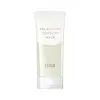What's inside
What's inside
 Key Ingredients
Key Ingredients

 Benefits
Benefits

 Concerns
Concerns

 Ingredients Side-by-side
Ingredients Side-by-side

Water
Skin ConditioningDipropylene Glycol
HumectantButylene Glycol
HumectantGlycerin
HumectantSilica
AbrasivePEG-20
HumectantPEG/PPG-14/7 Dimethyl Ether
Skin ConditioningPEG-240/Hdi Copolymer Bis-Decyltetradeceth-20 Ether
StabilisingPhenoxyethanol
PreservativeCarbomer
Emulsion StabilisingMethylparaben
PreservativePotassium Hydroxide
BufferingDipeptide-15
Skin ConditioningParfum
MaskingDisodium EDTA
Alcohol
AntimicrobialSodium Metabisulfite
AntioxidantLysine Hcl
Skin ConditioningScutellaria Baicalensis Root Extract
AstringentSodium PCA
HumectantBHT
AntioxidantRosmarinus Officinalis Leaf Extract
AntimicrobialPrunus Persica Kernel Extract
MoisturisingKaempferia Galanga Root Extract
Skin ConditioningSaxifraga Sarmentosa Extract
Skin ConditioningCI 47005
Cosmetic ColorantCamellia Sinensis Leaf Extract
AntimicrobialSoluble Collagen
HumectantWater, Dipropylene Glycol, Butylene Glycol, Glycerin, Silica, PEG-20, PEG/PPG-14/7 Dimethyl Ether, PEG-240/Hdi Copolymer Bis-Decyltetradeceth-20 Ether, Phenoxyethanol, Carbomer, Methylparaben, Potassium Hydroxide, Dipeptide-15, Parfum, Disodium EDTA, Alcohol, Sodium Metabisulfite, Lysine Hcl, Scutellaria Baicalensis Root Extract, Sodium PCA, BHT, Rosmarinus Officinalis Leaf Extract, Prunus Persica Kernel Extract, Kaempferia Galanga Root Extract, Saxifraga Sarmentosa Extract, CI 47005, Camellia Sinensis Leaf Extract, Soluble Collagen
Tranexamic Acid
AstringentDipotassium Glycyrrhizate
HumectantSodium Acetylated Hyaluronate
HumectantSodium Hyaluronate
HumectantGlutamic Acid
HumectantPlant Ash Extract
Water
Skin ConditioningButylene Glycol
HumectantGlycerin
HumectantDipropylene Glycol
HumectantCetyl Ethylhexanoate
EmollientDiglycerin
HumectantPhthalic Anhydride
Behenyl Alcohol
EmollientC20 Olefin
Hydrogenated Egg Oil
Skin ConditioningPentaerythrityl Tetraethylhexanoate
EmollientErythritol
HumectantPolyethylene
AbrasiveDimethicone
EmollientPetrolatum
EmollientCopernicia Cerifera Wax
Batyl Alcohol
EmollientPEG-7 Glyceryl Cocoate
EmulsifyingMethacrylic Acid/Sodium Acrylamidomethyl Propane Sulfonate Copolymer
Trimethylsiloxysilicate
EmollientC8-9 Isoparaffin
SolventSodium Citrate
BufferingEthylene/Propylene Copolymer
AbrasiveSodium Metaphosphate
BufferingSuccinoglycan
Skin ConditioningCitric Acid
BufferingSodium Metabisulfite
AntioxidantPhenoxyethanol
PreservativeTranexamic Acid, Dipotassium Glycyrrhizate, Sodium Acetylated Hyaluronate, Sodium Hyaluronate, Glutamic Acid, Plant Ash Extract, Water, Butylene Glycol, Glycerin, Dipropylene Glycol, Cetyl Ethylhexanoate, Diglycerin, Phthalic Anhydride, Behenyl Alcohol, C20 Olefin, Hydrogenated Egg Oil, Pentaerythrityl Tetraethylhexanoate, Erythritol, Polyethylene, Dimethicone, Petrolatum, Copernicia Cerifera Wax, Batyl Alcohol, PEG-7 Glyceryl Cocoate, Methacrylic Acid/Sodium Acrylamidomethyl Propane Sulfonate Copolymer, Trimethylsiloxysilicate, C8-9 Isoparaffin, Sodium Citrate, Ethylene/Propylene Copolymer, Sodium Metaphosphate, Succinoglycan, Citric Acid, Sodium Metabisulfite, Phenoxyethanol
Ingredients Explained
These ingredients are found in both products.
Ingredients higher up in an ingredient list are typically present in a larger amount.
Butylene Glycol (or BG) is used within cosmetic products for a few different reasons:
Overall, Butylene Glycol is a safe and well-rounded ingredient that works well with other ingredients.
Though this ingredient works well with most skin types, some people with sensitive skin may experience a reaction such as allergic rashes, closed comedones, or itchiness.
Learn more about Butylene GlycolDipropylene Glycol is a synthetically created humectant, stabilizer, and solvent.
This ingredient helps:
Dipropylene glycol is technically an alcohol, but it belongs to the glycol family (often considered part of the ‘good’ alcohols). This means it is hydrating and gentle on skin unlike drying solvent alcohols like denatured alcohol.
As a masking agent, Dipropylene Glycol can be used to cover the smell of other ingredients. However, it does not have a scent.
Studies show Dipropylene Glycol is considered safe to use in skincare.
Learn more about Dipropylene GlycolGlycerin is already naturally found in your skin. It helps moisturize and protect your skin.
A study from 2016 found glycerin to be more effective as a humectant than AHAs and hyaluronic acid.
As a humectant, it helps the skin stay hydrated by pulling moisture to your skin. The low molecular weight of glycerin allows it to pull moisture into the deeper layers of your skin.
Hydrated skin improves your skin barrier; Your skin barrier helps protect against irritants and bacteria.
Glycerin has also been found to have antimicrobial and antiviral properties. Due to these properties, glycerin is often used in wound and burn treatments.
In cosmetics, glycerin is usually derived from plants such as soybean or palm. However, it can also be sourced from animals, such as tallow or animal fat.
This ingredient is organic, colorless, odorless, and non-toxic.
Glycerin is the name for this ingredient in American English. British English uses Glycerol/Glycerine.
Learn more about GlycerinPhenoxyethanol is a preservative that has germicide, antimicrobial, and aromatic properties. Studies show that phenoxyethanol can prevent microbial growth. By itself, it has a scent that is similar to that of a rose.
It's often used in formulations along with Caprylyl Glycol to preserve the shelf life of products.
Sodium metabisulfite is also known as Sodium Pyrosulfite. It is a preservative, antioxidant, and disinfectant.
As a preservative, it helps stabilize cosmetic formulas without affecting their color or scent.
Water. It's the most common cosmetic ingredient of all. You'll usually see it at the top of ingredient lists, meaning that it makes up the largest part of the product.
So why is it so popular? Water most often acts as a solvent - this means that it helps dissolve other ingredients into the formulation.
You'll also recognize water as that liquid we all need to stay alive. If you see this, drink a glass of water. Stay hydrated!
Learn more about Water